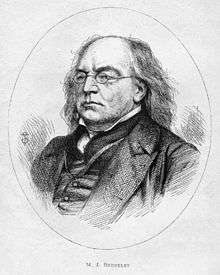Miles Joseph Berkeley
Miles Joseph Berkeley (1 April 1803 – 30 July 1889) was an English cryptogamist and clergyman, and one of the founders of the science of plant pathology. The standard author abbreviation Berk. is used to indicate this person as the author when citing a botanical name.[1]
Miles Joseph Berkeley | |
|---|---|
 | |
| Born | 1 April 1803 |
| Died | 30 July 1889 (aged 86) |
| Nationality | British |
| Occupation | vicar |
| Known for | Outlines of British Fungology |
| Awards | Royal Medal (1863) |
Life
Berkeley was born at Biggin Hall, Benefield, Northamptonshire, and educated at Rugby School and Christ's College, Cambridge.[2] Taking holy orders, he became incumbent of Apethorpe in 1837, and vicar of Sibbertoft, near Market Harborough, in 1868. He acquired an enthusiastic love of cryptogamic botany (lichens) in his early years, and soon was recognized as the leading British authority on fungi and plant pathology. Christ's College made him an honorary fellow in 1883.[2]
He was well known as a systematist in mycology with some 6000 species of fungi being credited to him, but his Introduction to Cryptogamic Botany, published in 1857, and his papers on Vegetable Pathology in the Gardener's Chronicle in 1854 and onwards, show that he had a broad grasp of the whole domain of physiology and morphology as understood in those days. Berkeley began his work as a field naturalist and collector, his earliest objects of study having been the mollusca and other branches of zoology, as testified by his papers in the Zoological Journal and the Magazine of Natural History, between 1828 and 1836.[3]
As a microscopist he was an assiduous and accurate worker, as shown by his numerous drawings of the smaller algae and fungi, and his admirable dissections of mosses and Hepaticae. His investigations on the potato murrain, caused by Phytophthora infestans, on the grape mildew, to which he gave the name Oidium Tuckeri, and on the pathogenic fungi of wheat rust, hop mildew, and various diseases of cabbage, pears, coffee, onions, tomatoes, and other plants, were important in results bearing on the life-history of these pests, at a time when very little was known of such matters, and must always be considered in any historical account of the remarkable advances in the biology of these organisms made between 1850 and 1880. When it is remembered that this work was done without any of the modern appliances or training of a properly equipped laboratory, the real significance of Berkeley's pioneering work becomes apparent. It has been said that
"... when the history of Plant Pathology is elaborated, Berkeley's name will undoubtedly stand out more prominently than that of any other individual. In fact, it is not saying too much to pronounce Berkeley as the originator and founder of Plant Pathology."[4]
As the founder of British mycology, his significant work is contained in the account of native British fungi in Sir William Jackson Hooker's British Flora (1836), in his Introduction to Cryptogamic Botany (1857), and in his Outlines of British Fungology (1860). His herbarium at the Royal Botanic Gardens, Kew, is one of the world's most extensive, containing over 9000 specimens as well as numerous notes and sketches.[5]
Berkeley corresponded with Anna Maria Hussey assisting her with identifying specimens while she supplied specimens she had collected to add to his herbarium.[6]
In 1857, Miles Joseph Berkeley was elected as member of the German Academy of Sciences Leopoldina.[7]
In June, 1879 he was elected a Fellow of the Royal Society and was awarded their Royal Medal in 1863.[8]
He died at his vicarage, Sibbertoft, near Market Harborough, on 30 July 1889. [3]
Family
Berkeley was the father of the scientific illustrator Ruth Ellen Berkeley[9][10] and named Agaricus ruthae (now known as Pleurotus ruthae) for her.[11]
See also
Notes
- IPNI. Berk.
- "Miles Joseph Berkeley (BRKY820MJ)". A Cambridge Alumni Database. University of Cambridge.
- Boulger 1901.
- Massee, George (1913). . In Oliver, Francis Wall (ed.). Makers of British Botany. Cambridge University Press. pp. 225–232.
- Chisholm 1911.
- "Anna Maria Hussey". Linda Hall Library. Linda Hall Library of Science, Engineering & Technology. Retrieved 3 April 2016.
- http://www.leopoldina.org/de/mitglieder/mitgliederverzeichnis/member/1965/
- "Library and Archive Catalogue". Royal Society. Retrieved 13 December 2010.
- "Ruth Ellen Berkeley - born in 1846 in Cliffe Northamptonshire Kings Cliffe - 1851 England & Wales Census". www.rootspoint.com. Retrieved 18 November 2017.
- Francis, John Collins (1909). Notes by the way. With memoirs of Joseph Knight, F.S.A., dramatic critic and editor of 'Notes and queries,' 1883-1907, and the Rev. Joseph Woodfall Ebsworth, F.S.A., editor of the Ballad society's publications. London: T.F. Unwin. pp. 109.
- Berkeley, Rev M. J.; Broome, C. E. (1 March 1879). "XXIV.—Notices of British fungi". Annals and Magazine of Natural History. 3 (15): 202–212. doi:10.1080/00222937908694086. ISSN 0374-5481 – via Biodiversity Heritage Library.
References


Further reading
| Wikisource has original text related to this article: |
- Taylor, George (1970). "Berkeley, Miles Joseph". Dictionary of Scientific Biography. 2. New York: Charles Scribner's Sons. pp. 18–19. ISBN 0-684-10114-9.
- Griffith, John William; Henfrey, Arthur; Berkeley, Miles Joseph; Jones, Thomas Rupert (1883). The Micrographic Dictionary; A Guide to the Examination and Investigation of the Structure and Nature of Microscopic Objects, Illustrated by Fifty-Three Plates and Eight Hundred and Eighteen Woodcuts, Containing Figures of 2680 Objects. Volume II -- Plates. London: John Van Voorst. Retrieved 7 April 2009.
External links
| Wikimedia Commons has media related to Miles Joseph Berkeley. |
- Works by Miles Joseph Berkeley at Project Gutenberg
- Works by or about Miles Joseph Berkeley at Internet Archive
- Descriptions of Moss families, illustrated by scans adapted from Rev. M.J. Berkeley's 'Handbook of British Mosses', with updated names.
- Descriptions of Mushrooms and Toadstools, illustrated by scans from M.J. Berkeley's ‘Outlines of British Fungology’, with updated names.